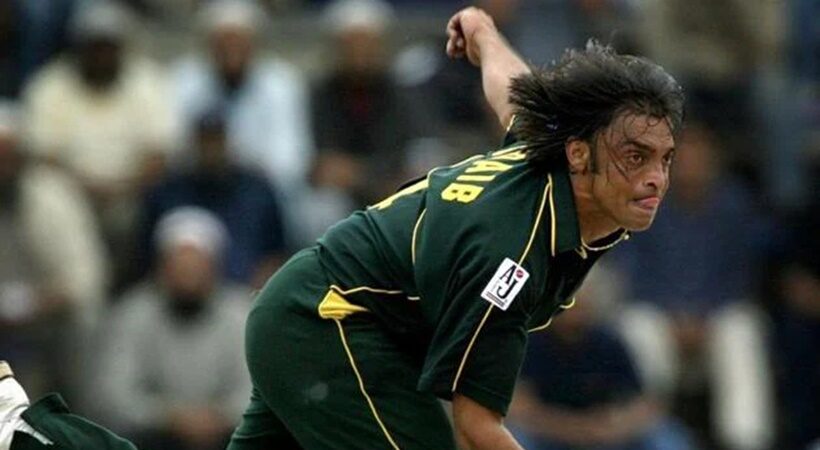Circa 1999, a new quickie burst into the horizon, of whom nothing was on record apart from the fact that he can hurl the fastest of the deliveries. The bowler happened to be a 24-year-old Shoaib Akhtar, the Rawalpindi Express, who was pitted against the “Wall” of Indian cricket Rahul Dravid. After spending close to an hour, consuming 90-odd deliveries, Dravid got the ball of his life from Shoaib, a searing yorker that swerved in to crash his leg stump. The commentator at that time could not have been more precise, “ Dravid had two options, either to save his stump or his right leg, he chose the latter.” A pall of gloom started to envelop an electrifying Eden Gardens stadium in Kolkata. If this was not enough then what followed almost sealed the fate of India in the Asian Test Championship against arch-rivals Pakistan.
In came the “God Of Indian Cricket”, Sachin Tendulkar, to replace the “Wall” only to receive almost an identical delivery from the Pak bowler. Another unplayable yorker that did not move much in the air but had enough wind to sail past the bat of Sachin to uproot the middle stump off the ground. The faint hope that remained after the exit of Dravid at the Indian equivalent of England’s Lord’s dissipated soon after this particular incident but the lesson in these two dismissals became apparent to everyone. Yorkers if executed properly can dislodge the best in the business. Hence, let us explore how yorkers have evolved over the years in cricket rather than delving more into the infamous Kolkata Test.
Not Easy But Akram Aced It
Not just Shoaib Akhtar, even Wasim Akram and Waqar Younis had some of the most lethal yorkers in the world cricket. In fact, Akram could bowl such deliveries at will. It is not easy to bowl yorkers as it could easily turn into a juicy full-toss, waist-high full toss or worse a beamer. However, Akram invariably got it right and his bowling partner Waqar also delivered such deliveries, which were later on dubbed as toe crushers, injurious to the stumps as well as batsmen’s lowest part of the legs.
Not only these there were others as well like Curtly Ambrose, Brett Lee, Dale Steyn etc who bowled yorkers at defining moments of the games to dislodge the most fancied batters. But these players belonged to an era when T-20 was an unknown format in the world of cricket and even the edges and sweet spots of the bats were not very thick. But once the edges and the middle parts of the bat got fatter, even the yorkers got despatched to the ropes with ease by the batsmen after giving themselves ample room wide outside the three stumps. So, to counter this, bowlers these days have developed other types of yorkers to check the flow of runs from the blade of the batsmen, especially in the T-20 format.
In the slam-bang version of cricket, where every batter has got the licence to kill bowlers had no option but to be more imaginative with their yorker-length deliveries. So, in came slow and wide yorkers. Among these two, wide yorkers have now started gaining currency in the T-20 and ODI formats and are raining like cats and dogs match after match. Wide yorkers, unlike the traditional ones, do not guarantee wickets even if executed to perfection but can definitely be dot balls, which are worth platinum in T-20s and ODIs.
What Do You Mean By A Wide Yorker?
The length is very much like the conventional yorker, full length, it is the line that sets the wide yorker apart from the traditional one. It lands between the wide marker and the off stump, roughly between the fifth and seventh stump. This delivery becomes a tough nut to crack for the batsmen, provided they have the knowledge beforehand that the bowler is going to land the bowl wide outside the off stump. If such yorkers land perfectly, then batters might miss the delivery or get faint edges or thick edges to be caught by the wicket-keeper or fielder at point respectively. Therefore, a batsman could end up becoming a stick in the mud, to quote Navjot Singh Sidhu, while facing such yorkers.
However, if a bowler does not get it right, then the wide yorker can turn out to be a potential gold mine for the opposition team. If the bowl lands outside the wide marker, the bowler has no option but to deliver the ball again, apart from conceding an extra run to the batting team. Or worse, if it goes too wide off the marker, the ball might even dodge the keeper to reach the ropes, giving away 5 runs and an extra delivery to the other team. So, the margin of error is very less with wide yorkers and bowlers need to be bang on target.
Bowlers’ Trump Card These Days
The wide yorkers have become very common in T-20 and ODI these days. When India toured South Africa for the three-Test and ODI series late last year, the Proteas bowlers used these deliveries to good effect against the Indian batters to stem the flow of runs, especially in the death overs. In the recent edition of the IPL also, the wide yorkers were employed with great precision. When RR locked horns with Mumbai Indians in the IPL 2022, the latter needed 29 runs off the last over. Navdeep Saini was the bowler and Kieron Pollard wielded the willow. Anything can happen these days in the fast and furious world of T-20 with big hitters like Pollard or Sanju Samson in full flow. However, Saini’s wide yorkers were right there on the money as he bowled six of them and conceded just five runs, only 4 came off the batters’ blade. There were other instances too in international cricket where wide yorkers came to the rescue of the bowling side in crunch situations.
Practice Yorker To Nail It
The only issue with yorkers, wide, slow or usual, is that they need to be on target. If they do not come off as intended then there could be a major catastrophe as well. So, bowlers have to perfect yorkers, irrespective of the type, at the nets before bowling at critical junctures in matches. And don’t be surprised if bowlers come with a new yorker variant in future as the game is increasingly gravitating towards the batsmen. There needs to be a balance between the ball and the bat in cricket, and yorkers are perfect tools to bridge the wide gap between the two.



















